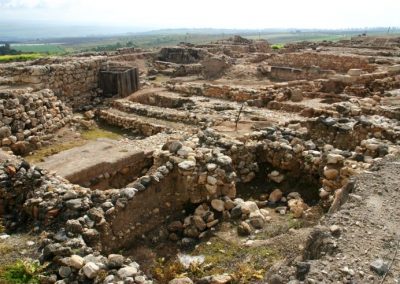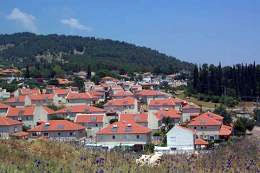 |
| ruins of ancient Hazor, courtesy, izbitour.com |
Hazor
was
a fortified city between Ramah and Kadesh, allotted to the tribe of Naphtali in
northeastern Israel, and located on the high ground overlooking Lake Merom
(today Lake Huleh). The original inhabitants of the city were the Canaanites. During
the time of the Israelite conquest under Joshua, Hazor’s king, the powerful
Jabin, summoned all the surrounding kings to create a defense alliance against
the Israelites. But Joshua defeated the allied forces, and burned the city to
the ground (Josh. xi. 1-5, 10-13). The Canaanites must have, later, rebuilt the
city for in the time of Deborah and Barak there was another King Jabin reigning
there (Judges iv. 2), to whom Israel was temporarily made subject in punishment
for its sins. But Israel once again conquered the city and this time, it
remained in Israelite hands ever since. In the later history of Israel, Hazor
is mentioned again when its inhabitants were carried off to Assyria by
Tiglath-pileser (II Kings xv. 29). After the Babylonian Captivity, Hazor
was only sporadically settled until it was abandoned altogether.
The site remained in ruins for
thousands of years afterwards, save for the nearby Tomb
of Honi the Circle-Maker.
According to Jewish legend, Honi, a first century BCE rabbi and scholar, had
the power to bring rain through his prayers. His burial site adjoins the burial sites of two of his grandsons, Abba
Hilkiyah and Hanan HaNihba. Many centuries later, his tomb would become a
major pilgrimage site.
 |
| Hazor HaGlilit, courtesy TownsOfIsrael.netzah.org |
After Israeli
independence in 1948, the new town of Hatzor HaGlilit, located near the ancient Hazor and
surrounding the Tomb of Honi the Circle-Maker, was founded in 1952–1953 as
a transition camp housing Jewish refugees,
primarily from
North Africa.
From 1955 to 1958, four large excavation campaigns – the
James A. de Rothschild Expedition – took place under the direction of Yigal Yadin
on behalf of the Hebrew University, with the aid of PICA, the Anglo-Israel
Exploration Society, and the Israel government. A fifth archaeological campaign
took place in 1968.
In 1956,
Hatzor HaGlilit was given the status of local council. By 1958, Hatzor HaGlilit
had a population of 4,000 and received development town status. Over
time, the city preserved its Jewish religious-traditional demographic status
and later a Jewish ultra-orthodox neighborhood was also established,
housing Gur Hassidim.


No comments:
Post a Comment